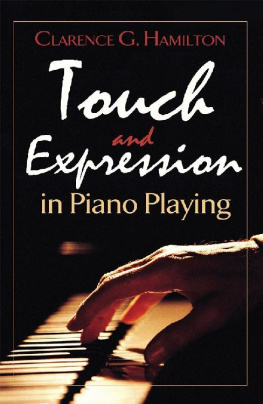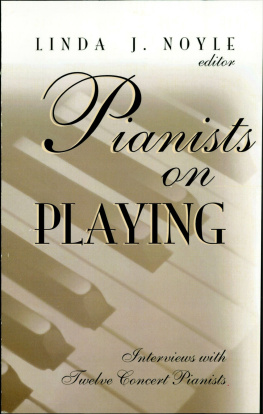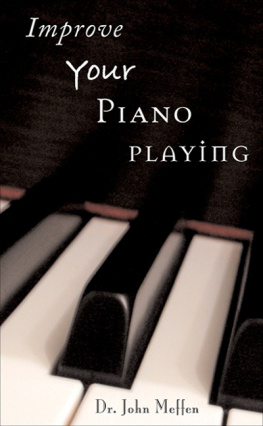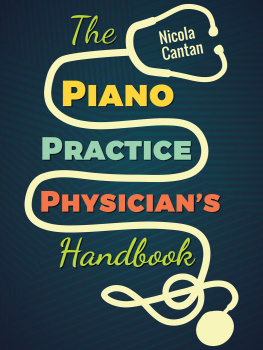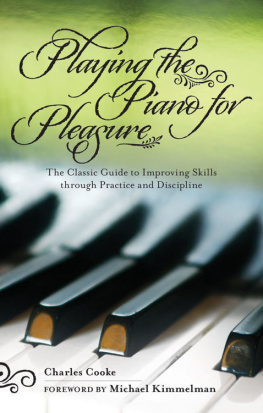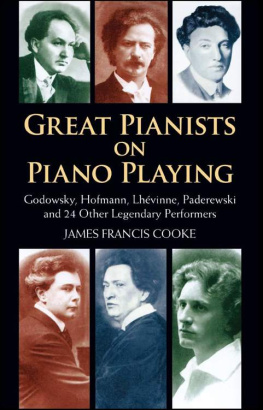Touch and Expression
in Piano Playing
CLARENCE G.HAMILTON
Dover Publications, Inc.
Mineola, New York
Bibliographical Note
This Dover edition, first published in 2012, is an unabridged republication of the work originally published by Oliver Ditson Company, Boston, in 1927.
Library of Congress Cataloging-in-Publication Data
Hamilton, Clarence G. (Clarence Grant), 18651935.
Touch and expression in piano playing / Clarence G. Hamilton.
p. cm.
Reprint; originally published: Boston : Oliver Ditson, 1927.
eISBN-13: 978-0-486-32097-7
1. PianoInstruction and study. I. Title.
MT225.H23 2012
786.2193dc23
2012018251
Manufactured in the United States by Courier Corporation
48828401
www.doverpublications.com
CONTENTS
FOREWORD
If he is to build a house, a carpenter must be supplied with adequate and properly sharpened tools; he must be expert in applying these tools to any demand that may arise; and he must have acquired the ability to follow out the plans of the architect, and to realize the latters vision in the completed edifice. Just so, the pianist must possess fingers and muscles that are fitted to perform their intricate tasks; he must know how to manipulate the keys so as to produce every possible kind and gradation of tone; and he must be able to follow out the design of a given piece so as to realize in detail and as a whole the structure which was idealized in the composers mind.
In the following pages I propose to treat of the means by which this final result is to be obtained. Given a person of normal conditions as to fingers, hand and arm, we shall proceed to inquire (1) in what ways these factors may be most effectively utilized to bring the fingers into contact with the keys, and (2) how such contact may be directed to the artistic interpretation of a composition. Of these two processes, the first has to do with kinds of touch, and the second with the application of touch to expression.
Touch and Expression
in Piano Playing
PART I. TOUCH
B EFORE considering the matter of touch, let us thoroughly free our minds from bias in favor of any one of the so-called methods of piano technic, however excellent such method may be. Let us remember that piano playing has been through a process of evolution during more than two hundred years, while players and teachers have stumbled along, experimenting in this way and that, many times propagating ideas that have afterward been supplanted by much better ones. Pupils of famous teachers, too, have often slavishly followed out their dicta, long after more enlightened methods have been invented by progressive players. Such masters as Liszt and Chopin, for instance, employed a new freedom of technic which amazed the adherents of the cut-and-dried systems of Hummel, Czerny and their followers, and which was correspondingly slow of general adoption.
In recent years, however, the searchlight of modern science has been directed upon piano playing, as upon most other subjects; with the result that, setting aside the empirical precepts that were formerly accepted as law and gospel, players and teachers have scientifically investigated the relative values for playing purposes of the muscles of the arm and hand, and have determined how these muscles may best be directed and cordinated to produce desired effects. Having such knowledge at his command, the individual player can judge for himself what kinds of touch to apply to a given passage, and can test intelligently the statements and suggestions of instructors and their methods.
Useless Motions
Let us, at the outset, distinguish carefully between essential and non-essential muscular movements. To the latter class belong those gyrations, such as throwing the arms up in the air, or jerking the hand violently back from the wrist, which are employed either to catch the crowd or through ignorance of the keyboard mechanism, and which are as musically useless as were the antics of the old-time drum-major. With such movements may be listed the unnecessary pressure on a key after it has been sounded, which has no other result than to stiffen the performers wrist, since it takes place after the hammer has fallen back from the string.
Relaxation
Before he proceeds to the study of piano touch, the student should acquire the ability to relax thoroughly all the muscles which have to do with playing; for without such ability he is as badly off as the sculptor who tries to fashion an image out of unyielding clay.
Next, he should gain such control over the playing factors that any given muscle or combination of muscles will respond instantly to his call, without interference from others.
APPLICATION.To secure complete relaxation, sit before the keyboard and let the right arm hang down from the shoulder. Press the fingers downward, so that their tips approach the floor as nearly as possible, and then let go.
A powerful muscle which is almost constantly in use is the biceps in the upper arm. Employing this muscle, raise the forearm, with the hand still relaxed, until the hand hangs over the keys with the fingers pointing downward as in ).

ILLUSTRATION A

ILLUSTRATION B
Return to the former position above the keys, and lastly to the first position, with the arm at the side. These motions should be repeated a number of times with each hand.
Classes of Touch
Having thus established the basic condition of hand and arm, we are prepared to study tone-production. Since the direct medium for this lies in the depression of the keys by the fingers, we have then to discover just how this depression is best effected; or, in other words, what are the most useful and legitimate kinds of touch.
While many varieties of touch have been employed during the entire history of piano playing, those chiefly used by the modern pianist are four in number, distinguished by the different ways in which the energy that is transmuted through the finger-tips is generated in the muscular activities of hand, arm and shoulder.
Forearm Rotation
A valuable aid to all four of these touches is known as forearm rotation. We have all heard the expression as easy as turning the hand over. But it has been discovered that this extremely simple movement, which necessarily involves also the forearm, may, if properly applied, generate a considerable degree of force to add to the pianists stock-in-trade. For each hand, this motion may be toward either the right or the left; and according to the rapidity of the movement is force added to the depression of the key.

ILLUSTRATION C

ILLUSTRATION D
APPLICATION.Hold the right hand above the keyboard, as in . Now, lower the arm until the finger-tips rest on the treble keys c, d, e, f, g: with the wrist held rather high, and the elbow hanging loosely at the side.

Next page
